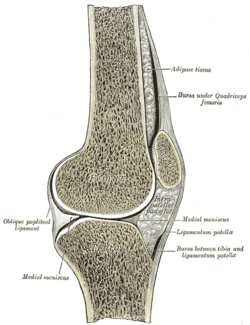Bumper fracture
| Bumper fracture | |
|---|---|
| Classification and external resources | |
 Sagittal section of right knee-joint. (Tibia and fibula visible.) |
A Bumper fracture is a fracture of the lateral tibial plateau caused by a forced valgus applied to the knee. This causes the lateral part of the distal femur and the lateral tibial plateau to come into contact, compressing the tibial plateau and causing the tibia to fracture. The name of the injury is because it was described as being caused by the impact of a car bumper on the lateral side of the knee while the foot is planted on the ground,[1] although this mechanism is only seen in about 25% of tibial plateau fractures.[2]
Fracture of the neck of the fibula may also be found, and associated injury to the medial collateral ligament or cruciate ligaments occurs in about 10% of cases.[3]
References
- ↑ Bumper fracture at e-radiography.net
- ↑ Tibial Plateau Fractures at eMedicine
- ↑ APLEY AG (August 1956). "Fractures of the lateral tibial condyle treated by skeletal traction and early mobilisation; a review of sixty cases with special reference to the long-term results". J Bone Joint Surg Br 38–B (3): 699–708. PMID 13357593. Retrieved 2009-10-11.
| |||||||||||||||||||||||||||||||||||||||||||||||||||||||||||||||||||||||||||